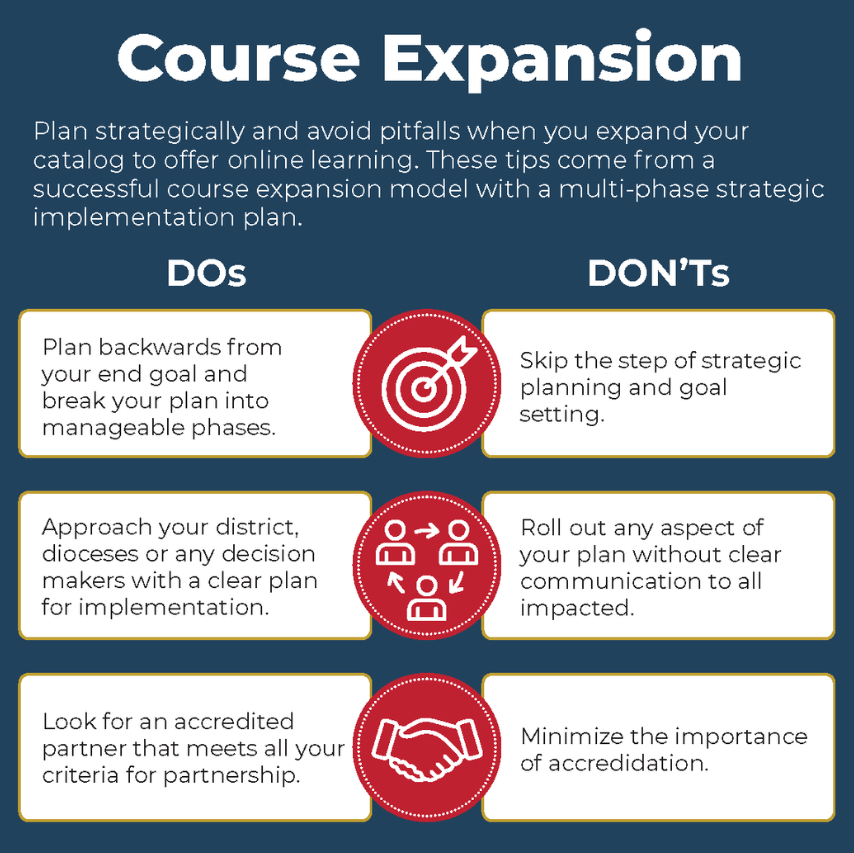How Catholic Schools Can Modernize Their Curriculum with Online Learning
September 2023
World Youth Day 2023 concluded in Lisbon, Portugal, with Pope Francis saying mass for a gathered crowd of 1.5 million people. The main themes that the Pope focused on throughout the World Youth Day celebration were peace and technology. This is not surprising, considering this is the first pontiff with a Twitter account.
Pope Francis asked, “What new paths should we follow to cast off the shackles of our old habits, to be better prepared, to dare new things? What signs of life and hope can we see to help us move forward and try to make our world a better place?”
If you weren’t able to attend World Youth Day 2023 in person, you could have joined the millions more around the world who watched live streams of the various proceedings on phones, tablets, and laptops. Throughout his tenure, the Pope has been unafraid of connecting with the youth of the world through technology. Just as with online learning, the means are often as important as the message. Online learning is much more than education; it’s about attracting new students, providing more options to existing students, and enhancing students’ engagement.
Online learning and the personal touch
One of the greatest hurdles facing online learning is the misconception that it is detached, even robotic. A closer examination reveals that this is an outdated way of looking at online learning. Adaptive technologies allow you to track a student’s strengths and weaknesses in an objective way. Removing the possibility of impartiality empowers faculty to better understand the student through analysis. Areas that need focus can be identified and improved upon specific to an individual student’s needs.
The value of today’s online learning management systems go beyond facilitating instruction and delivering curriculum. A learning management system can maintain clear channels of communication between teachers, students, and parents, a historically inconsistent triangle of correspondence. Messages, instructional material, discussions, and assessments are all rolled up in one place.
Enhancing students’ learning
There are many ways the traditional classroom learning experience can be limiting. For one, all interactions between student and teacher are fixed in time and place. Recorded lessons break that mold. Students who missed a class have the ability to make it up. Recorded lessons can also serve as an important review aid.
The student learning experience is not just an individual endeavor. The group project and group study dynamic is expanded with online learning. Students can meet in real time from anywhere in the world. Moreover, students are no longer beholden to convening during school hours, seeking transportation, or finding a venue to meet.
Preparedness for the future
Online meetings became a way of life in schools and in the business world during the pandemic. The framework of this model continues today. Currently, nearly half of all college students take classes exclusively online or in a blended format, while one in ten postsecondary institutions offer courses primarily online. Considering these statistics and the continued use of virtual work in business, students in primary and secondary school will be better prepared for their future if their learning includes online experiences.
Learning proper online decorum is as important in acting like a professional as punctuality, work ethic, and dependability. Students learn appropriate behavior in an online classroom, just as one hopes they might in the traditional classroom setting. It is worth noting that in a survey of current college students, 97% expect a high return on their investment in online learning, which is the highest level in the history of the report. As the geographical world shrinks, the online universe grows. Students who learn how to conduct themselves in both arenas have an advantage moving forward.
Naturally, these online tools are developed for students, but teachers and faculty can be tangential beneficiaries of online learning. Professional development is an ongoing endeavor for teachers and administration. Mastering online learning platforms is a way to keep up with the latest technologies, connect better with students, and improve a professional skill set.
Extended community through online learning
Consider what technology has done for World Youth Day. Started by Pope John Paul II in 1986 as a way to reignite the younger demographic of the Catholic Church, it grew in a steady, predictable way. But, with Pope Francis’s addition of online outreach, attendance has exploded, reaching millions more—from youth to adults, to Catholics and non-Catholics—all from their digital devices.
You can only dream of having the kind of digital reach that the Pope enjoys. Nonetheless, it is possible to extend the Catholic school community beyond school walls. People can engage with prayer sessions and masses at times that are convenient for them. Alumni outreach can be reinvigorated online as well. All to say, online learning has reach beyond the classroom.
The modern curriculum
Catholic Virtual is the online partner that hundreds of K–12 Catholic schools worldwide trust to help create a modern curriculum for today’s students. As a Cognia-accredited Catholic school partner, we are committed to providing students with the same high-quality Catholic school education they receive within your classroom walls. We offer a wide range of online courses and work with your school to develop a customized program that will allow you to attract new students, provide more options to existing students, and enhance students’ engagement.
To learn more about Catholic Virtual, please visit CatholicVirtual.com or call 772-277-2281 today.
There are many options available to expand your school’s course catalog with online learning, but very few provide the combination of academic excellence, expertise in online instruction, and Catholic values your school needs.
Catholic schools are renowned for their commitment to academic excellence and religious education. However, in today’s evolving landscape, Catholic schools face unique challenges in retaining students and fostering enrollment growth. One way to help schools engage students and appeal to a wider audience is by expanding the curriculum with online courses—providing many benefits to students and your school. In this guide, we will explore the benefits of integrating online courses and provide practical insights to help navigate this path successfully.
Benefits of Integrating Online Courses
To meet the diverse needs of your students, expanding the course catalog through online courses offers several advantages. Keep reading to discover six key benefits of integrating online courses into a traditional Catholic school:
Benefit 1:
Increase the attractiveness of your school to prospective and current students
- A robust offering of courses, including a wide range of electives, increases the attractiveness of your school and improves the chances a student will enroll. Online courses from a quality partner allow you to attract new students with a wide selection of interesting courses such as Advanced Placement® and honors, web design, business, cybersecurity, music, and more.
- Students attending your school are more engaged in learning, and more likely to stay enrolled in your school, when you have an interesting array of course options.
- Courses from an accredited partner with high-quality teaching can provide a learning experience with the same high standards as you deliver in the classroom.
Benefit 2:
Offer flexible learning options
- Many online courses can be taken as an independent study, with students learning outside the classroom on a very flexible schedule. This allows students to take additional courses without interfering with their regular school schedule.
- A hybrid learning approach, with students learning in person and online, can provide a very engaging learning experience due to its flexibility and the combination of in-person, online, and independent instruction and study methods.
Benefit 3:
Provide an easy option for high school students to recover lost credits
- Even the best students sometimes struggle with a subject in high school and fail to earn credit toward graduation. Online courses are ideal for high school credit recovery because they are created to focus on the subject matter a student needs to learn to be successful and adapt accordingly.
- Credit recovery courses can be completed in less than a full semester, making them ideal for learning during the summer. Online credit recovery courses can be delivered without hiring another teacher to instruct during the summer break.
Benefit 4:
Give Students the Opportunity to Learn Over the Summer
- Your school can offer an extensive range of courses during the summer when they are delivered online. Summertime is an excellent time for students to explore new topics, move ahead in their studies, or make up lost high school credits. An online learning provider can supply your school with a wide variety of courses during the summer, from core, to elective, to religion courses.
- You can avoid many of the administrative tasks associated with running a summer school program when you partner with an online education provider, allowing you to focus instead on preparing for the upcoming school year.
Benefit 5:
Fulfill the school’s mission of providing religious instruction
- Central to a Catholic school education is instruction in faith. Online religion courses can give your school flexibility and add depth to your religious instructional offerings. While not a replacement to in-person religious instruction, online courses can be an excellent complement to your program.
- A high-quality, online, Catholic school partner is equipped to help you deliver on your school’s mission to educate the mind and spirit of your students. Choose to partner with an organization that can deliver not only on academic excellence, but also understands the central role of the Catholic faith in your school.
Benefit 6:
Offer cost-effective and flexible solutions
- There is no need to hire additional teachers. For example, if students in your school are interested in learning Latin, you may struggle to find a qualified teacher. With an online course, a highly qualified Latin teacher can instruct your students from wherever they live, saving you the trouble of hiring and the cost of a teacher’s salary.
- There are no minimum class sizes. If you have one student or 30 students interested in a subject, an online course can readily accommodate both scenarios. For specialized subjects where student demand may be unpredictable, you do not need to worry about having to cancel a course if enrollment is insufficient—or bear the cost of teaching a very small class.
- An online course may cost less than your school’s tuition, giving you the opportunity to use this difference to improve students’ learning experience in other ways.
- Online courses can be up and running quickly, allowing you to add courses even up until soon before the start of the semester.
More Articles
Let Us Help You
Or, Contact Us by Phone
U.S.: 1-772-783-1178
Int'l: 1-772-293-9657
Let Us Help You
Or, Contact Us by Phone
U.S.: 1-772-783-1178
Int'l: 1-772-293-9657
Accreditations and affiliations ensuring a world-class online and blended education








 Student Login
Student Login